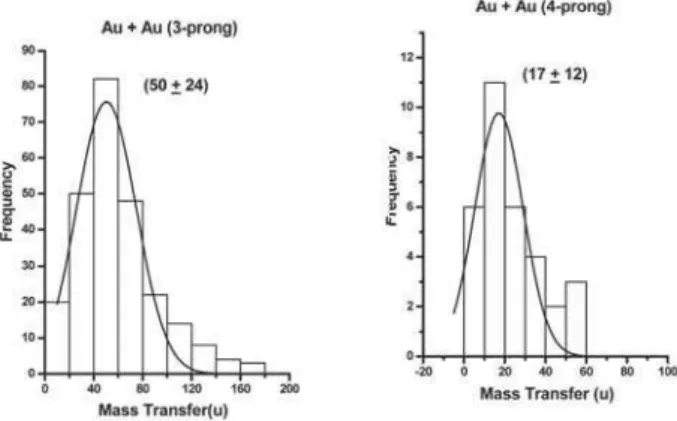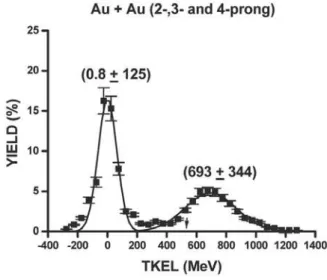Brazilian Journal of Physics, vol. 39, no. 3, September, 2009 539
Sequential And Double Sequential Fission Observed In Heavy Ion Interaction Of (11.67
MeV
/
u
)
197Au
Projectile With
197Au
Target
Tabassum Nasir∗
Department of Physics, Gomal University, Dera Ismail Khan, Pakistan
Ehsan Ullah Khan
Department of Physics, CIIT, Islamabad, Pakistan
Javaid Jahan Baluch
Department of Environmental Sciences, CIIT, Abbottabad, Pakistan
Shafi-Ur-Rehman
ISL Project, PAEC, Dera Ghazi Khan, Pakistan
Matiullah
Physics Division, PINSTECH, Nilore, Islamabad, Pakistan
Muhammad Rafique
Department of Physics, University of Azad Jammu and Kashmir, Muzaffarabad, Pakistan.
(Received on 28 February, 2009)
The heavy ion interaction of 11.67 MeV/u197Au+ 197Auhas been investigated using mica as a passive detector. By employing Solid State Nuclear Track Detection Technique the data of elastic scattering as well as inelastic reaction channel was collected. The off-line data analysis of multi-pronged events was performed by measuring the three-dimensional geometrical coordinates of correlated tracks on event-by-event basis. Multi-pronged events observed in this reaction were due to sequential and double sequential fission. Using a computer code PRONGY based on the procedure of internal calibration, it was possible to derive quantities like mass transfer, total kinetic energy loss and scattering angles.
Keywords: Heavy Ion Interaction, mica track detector, multi- pronged events, sequential fission, double sequential fission
1. INTRODUCTION
One of the most remarkable features of the reactions be-tween heavy projectiles and heavy targets is the ability of the nuclear system to convert hundreds ofMeV andGeVof rel-ative kinetic energy into internal excitation and deformation energy. The two heavy and excited fragments produced after the first stage of the interaction can decay into various de-cay modes from evaporation to multi-fragmentation includ-ing fission. The advanced particle detection systems [1] gen-erate a rich source for theoretical modeling of the underlying nuclear processes [2,3,4]. The collision of complex nuclei with each other, however, continues to defy a unified micro-scopic description. It is generally taken tactful to analyze reactions with respect to definite windows of incidence en-ergies and projectile-target combinations. At low enen-ergies (Elab<10 MeV/u) the major part of the total reaction cross-section is accounted for by the fusion-evaporation process with a single heavy residual nucleus. However, a binary pro-cess of fusion-fission type has also been observed together with quasi-elastic and deep inelastic scattering [5].These data are well explained on the basis of statistical model [6]. At the higher projectile energies the collision with heavy tar-gets gives rise to conditions favourable for the production
∗Electronic address:tabassum642003@yahoo.com
of quark-gluon plasma with specific effects on the nature and yield of observed particles. However, many of the re-sults on particle production can also be explained reasonably well by using Monte-Carlo event generators without invok-ing plasma formation [7].The intermediate energy region is rather broad, scattering from ∼10 MeV/u to several hun-dred MeV/u. The reaction mechanism at energies below 20MeV/uis dominated by mean field effects and changes gradually to single particle effects for incident particle en-ergy beyond Fermi enen-ergy.
In the present study from the analysis of multi-pronged events it has been observed that all the analyzed 3- and 4-pronged events were due to sequential and double sequential fission. For experimental verification we used mica as Solid State Nuclear Track Detector. This track detector system has been used in number of similar studies [8,9, 10,11].
2. EXPERIMENTAL DETAILS
540 Tabassum Nasir et al.
minutes in 40% HF. The total scanned area was 55.52cm2. Samples were scanned with an optical microscope (Leitz Or-thoplan) at a magnification of about 400×. The method of conversion of projected track lengths and azimuthal angles to actual track lengths and polar angles has been given in references [12,13].
3. ANALYSIS OF THREE AND FOUR PRONG EVENTS
For the conversion of three dimensional coordinates of multi-prong data i. e. track lengths and polar angles into physical quantities such as masses and velocities, we have used the well-known method of Gottschalk et al [14]. For this purpose a computer code PRONGY was used.
The following coupled equations are solved for the analy-sis of three-pronged events,
N
∑
i=1
miVi(li,mi)ˆei=Pin (1)
Vi(li,mi) =
2
∑
µ=0 4
∑
ν=0
Cµνmµil ν
i (2)
wheremidenotes the mass of theithfragment,liis the track length,Viis the velocity,eiis the unit vector along the track direction,Pinis the incident momentum and N being the mul-tiplicity of an event. The coefficientsCµνwere determined by an internal calibration method [14].
In the analysis of 4-pronged events, four unknown masses are to be determined. So in addition to equation (1) and (2), one more equation i.e equation for the conservation of masses is used.
N
∑
i=1
mi=mP+mT (3)
wheremPandmT are the projectile and target masses respec-tively.
4. RESULTS AND DISCUSSION
Total number of measured three and four-pronged events were 410 and 65 while total number of analyzed three and four- pronged events were 278 and 44 respectively i. e. 68% events were analyzed in both the cases.
After assigning velocities to the individual tracks, in each event, it is easy to determine the relative velocity between fission fragments. For three-pronged events, one out of three possible combinations of relative velocities and for four-pronged events, two out of six possible combinations were consistent with the expected value of equilibrated fission, i. e. about 2.4 cm/ns. Therefore in case of three-pronged events one such pair and in case of four-pronged events two such pairs were identified as fission fragments. These results strongly support the view of sequential and double sequential fission processes in the heavy ion reaction under study.
The values of fission fragments and pre-fission masses of three and four- pronged events are given in Table I and II. The
mean values and the standard deviations have been obtained by Gaussians fits to the experimental plots.
TABLE I: Fission fragment masses (in the second reaction step) and intermediate stage masses (in the first reaction step) of three-pronged events.
mi (u) mj (u) mk (u) mij (u) 91±66 156±77 147±90 247±99
TABLE II: Fission fragment masses (in the second reaction step) and intermediate stage masses (in the first reaction step) of four-pronged events.
mi (u) mj (u) mk (u) ml (u) mij (u) mkl (u) 88±40 126±40 68±34 112±36 214±19 180±18
4.1. Mass Transfer
Mass transfer is given by
∆m=
mi j−mH
+|mk−mL|
2 (for 3-pronged events)
(4)
∆m=
mi j−mH
+|mkl−mL|
2 (for 4-pronged events)
(5)
wheremH andmLare the masses of heavier and lighter in-teracting ions. The distributions of mass transfer plotted on event by event basis for three and four-pronged events are shown in Fig. 1. It can be noted that on the average a mass of (50±24) u and (17±12) u has been transferred for and 4-pronged events. So it is clear that mass transfer in 3-pronged events is high as compared to 4-3-pronged events.
Brazilian Journal of Physics, vol. 39, no. 3, September, 2009 541
FIG. 2: Distributions of TKEL in the first reaction step for 3- and 4-pronged events.
4.2. Total Kinetic Energy Loss (TKEL)
Total kinetic energy loss which is a measure of energy damping in the first step of the reaction is given by
T KEL=ELab− n
∑
i=1
(Ei,track−Ef) (6)
whereELabis the laboratory energy,Ei,trackis the kinetic en-ergy associated to each track, n is the multiplicity of the event andEf is the energy released in fission given by
Ef =
mimjv2i j 2(mi+mj)
for 3-pronged events
Ef =
mimjv2i j 2(mi+mj)
+
m
kmlv2kl 2(mk+ml)
for 4-pronged events
Fig. 2 shows the distributions of TKEL in 3-and 4-pronged events. For 3-pronged events TKEL is (752 ±195) MeV while for 4-pronged events it is (666±163) MeV. Average TKEL for 3-pronged events is slightly larger than that of the corresponding value in case of 4-pronged events.
Fig. 3 shows the energy loss spectra integrated over all reac-tion angles and multiplicities. The kinetic energy available above the Coulomb barrier is given by
Eavail=ECM−ECoul (7)
which is denoted by arrow on the horizontal axis. Its value is 532 MeV for Au + Au reaction at 11.67 MeV/u beam energy. The first peak at (0.8±125) MeV is due to elastic binary events and quasi elastic 3-pronged events while the second peak at (693±344) MeV is due to events obtained as a result of sequential and double sequential fission following deep inelastic collision.
4.3. Scattering Angles
The angular distributions of pre-fission masses (mi j and
mkl) and the surviving mass (mk) for three and four-pronged events in the first step are shown in Fig. 4. The angles sub-tended bymi j,mkl andmkwith respect to beam direction in
FIG. 3: Energy spectra for Au + Au reaction.
laboratory frame of reference are denoted byΘi j,ΘklandΘk respectively. It can be seen that in 3-pronged events pre-fission mass (mi j) scattered at smaller angle i.e. (18.7 ± 12.5)owhile surviving mass (m
k) scattered at larger angle i.e. (38.2±24.8)o. In case of 4-pronged events pre-fission mass (mi j) scattered at smaller angle i.e. (28.4 ±13.1)o while pre-fission mass (mkl) scattered at larger angle i.e. (33.5± 19.6)o.
FIG. 4: Angular distributions of intermediate stage masses in the first reaction step for 3- and 4-pronged events.
5. CONCLUSIONS
542 Tabassum Nasir et al.
ion interaction of 11.67 MeV/ u Au + Au.
It has also been observed that mass transfer in three-pronged events was high as compared to four-three-pronged events and also average TKEL for three particle exit channel was slightly larger than that of the corresponding value in four particle exit channel. After the first stage of the reaction, two intermediate masses show mass transfer among them de-pending on the TKEL at that stage of the reaction. Higher
value of mass transfer is accompanied by large TKEL. In the second stage of the reaction, one or both the fragments un-dergo fission, giving three or four particles at the exit chan-nel.
From the scattering angles of the intermediate masses it has been observed that the heavier of the two focused in the forward directions while the lighter one had broader peaks at higher values.
[1] H. Stelzer (1976). Nucl. Instrum. Methods, 133, 409. [2] S.I. Cavallaro (1998). Phys. Rev. C57, 731.
[3] M.B. Tsang et al. (1997). Phy. Rev. C55, R557. [4] C. Williams et al. (1997). Phy. Rev. C55, R2132. [5] C. Beck et al. (1998). Eur. Phys. J. A2, 281. [6] T. Matsuse et al. (1997). Phy. Rev. C55, 1380. [7] A. Drabrowski et al. (1998). Nucl. Phys. A633, 357. [8] I.E. Qureshi et al. 1997. Radiat. Meas., Vol. 28, 283.
[9] E.U. Khan , Qureshi I E, Shahzad M I, Khattak F N and Khan H.A (2001). Nuclear Physics A 690, 723-730.
[10] Tabassum Nasir, J.J. Baluch, E.U. Khan, F.N. Khattak and M.I. Shahzad (2006). Chinese Physics Letters Vol. 23, No. 10,
2714.
[11] Tabassum Nasir, E.U. Khan, J.J. Baluch, I.E. Qureshi, M. Sajid, , M.I. Shahzad, (2008). Radiation Measurements 43, S274-S278.
[12] I.E. Qureshi , M.I. Shahzad , S. Manzoor, H.A. Khan, 1994. The Nucleus 31, 25-33.
[13] E.U. Khan et al. (1991). Nucl. Tracks Radiat Meas., Vol. 19 No. 1-4, pp. 631-636.

